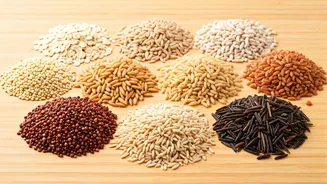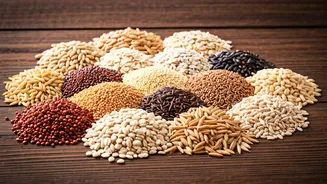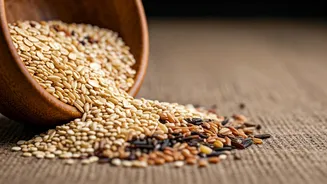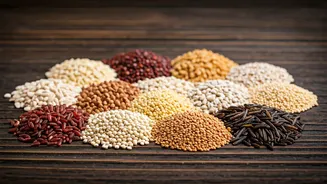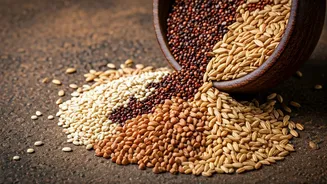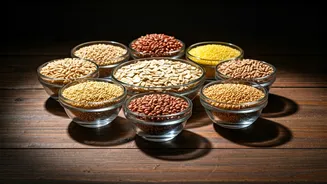Embrace Diabetes-Friendly Grains
Managing blood sugar is crucial for overall health, and your grain choices play a significant role. Refined grains can trigger rapid blood sugar increases,
while certain whole grains offer a gentler impact. Focusing on the right grains can prevent spikes and support weight management. Choosing these grains aligns with diabetes control and overall health. Each grain listed below provides specific benefits and can be incorporated into your diet, offering a delicious and nutritious way to manage blood sugar levels. These grains can assist in reversing blood sugar spikes and promote long-term weight control.
Oats: The Classic Choice
Oats, a breakfast staple, are an excellent choice for blood sugar management. They are high in soluble fiber, which slows down glucose absorption. This helps to prevent rapid blood sugar spikes after meals. Studies show that oats can improve insulin sensitivity, making them a fantastic addition to a diabetes-friendly diet. Oats are versatile. You can enjoy oatmeal, oat-based bread, or add them to smoothies. Consuming oats regularly can contribute to stable blood sugar levels and improved health.
Barley: Nutrient Powerhouse
Barley is another grain loaded with fiber and nutrients, ideal for blood sugar control. Its high fiber content reduces the rate at which sugar enters the bloodstream. This prevents sharp increases in blood sugar levels. Barley also offers a good amount of beta-glucan, a type of fiber that can improve insulin resistance. When incorporating barley into your diet, try it in soups, stews, or as a side dish. Barley can contribute to better blood sugar management and overall well-being.
Quinoa: A Complete Protein
Quinoa is a gluten-free grain that is an excellent source of protein and fiber. Unlike many grains, it provides a complete protein, meaning it contains all nine essential amino acids. Its high fiber content helps stabilize blood sugar levels, preventing spikes. Quinoa has a low glycemic index, further reducing its impact on blood sugar. Use quinoa in salads, as a base for meals, or as a substitute for rice. Quinoa offers a nutritious and effective way to manage blood sugar.
Brown Rice: A Healthy Option
Brown rice is a whole grain that offers a healthier alternative to white rice for blood sugar control. It has a lower glycemic index, preventing rapid blood sugar increases. Brown rice retains its bran and germ, rich in fiber and nutrients. This combination provides a slow release of glucose into the bloodstream, avoiding spikes. It is a nutritious choice that contributes to stable blood sugar levels and supports healthy eating. You can integrate brown rice into your diet by replacing white rice in meals. Regular consumption of brown rice can help manage blood sugar.
Bulgur: Quick and Easy
Bulgur, made from parboiled wheat kernels, is a quick-cooking grain that is beneficial for blood sugar control. Its high fiber content slows down glucose absorption. This, in turn, helps to avoid blood sugar spikes after meals. Bulgur has a relatively low glycemic index, making it suitable for people with diabetes. Bulgur can be used in salads, pilafs, or as a substitute for other grains. Bulgur provides a convenient and effective way to manage blood sugar levels.
Whole Wheat: The Choice
Whole wheat, with its high fiber content, is a beneficial choice for regulating blood sugar. Fiber slows the absorption of glucose, avoiding rapid spikes. Choosing whole wheat products over refined alternatives supports better blood sugar control and weight management. It's important to read labels, ensuring the product is whole wheat, not just enriched. This helps keep blood sugar levels stable, promoting overall health. Using whole wheat products, such as bread and pasta, is a smart way to manage blood sugar.
Amaranth: A Tiny Powerhouse
Amaranth is a tiny grain packed with nutrients, excellent for blood sugar management. It is a good source of fiber, which aids in slowing glucose absorption. This process helps prevent blood sugar spikes after meals. Amaranth is also rich in protein and other nutrients, making it a well-rounded food choice. It has a low glycemic index. Amaranth can be used in porridge, added to salads, or as a flour substitute. Regular consumption of amaranth can contribute to the stability of blood sugar levels.
Rye: High Fiber Content
Rye is a grain that boasts a high fiber content, which makes it suitable for blood sugar control. Its fiber content significantly reduces the rate at which sugar enters the bloodstream. This, in turn, prevents sharp increases in blood sugar. Rye has a low glycemic index. It’s often used in bread and other baked goods. It provides a filling and nutritious option that helps keep blood sugar levels stable. Including rye in your diet is beneficial for overall health.
Millet: Gluten-Free Benefit
Millet, a gluten-free grain, can be a great addition to a diabetes-friendly diet. It is a good source of fiber. This helps control blood sugar spikes after meals. Millet has a low to moderate glycemic index, contributing to stable blood sugar levels. Millet can be used in various dishes, like porridge or pilafs. Regular consumption of millet can contribute to a balanced diet. Millet is both nutritious and effective in managing blood sugar.
